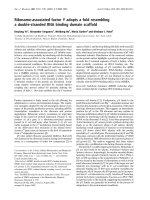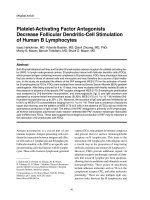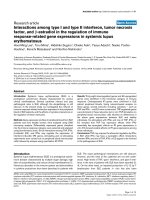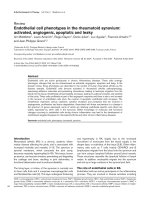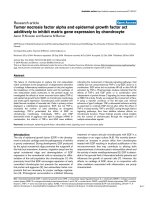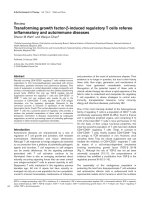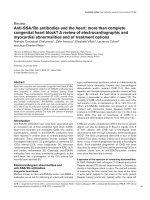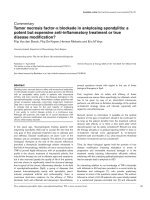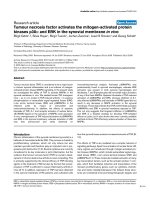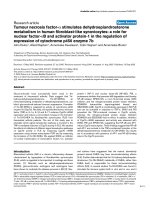Báo cáo y học: " Endothelial Recombinant factor VIIa and factor VIII treatment for acquired factor VIII deficiency: a case of repeated thrombotic endotracheal occlusion in a mechanically ventilated patient" pps
Bạn đang xem bản rút gọn của tài liệu. Xem và tải ngay bản đầy đủ của tài liệu tại đây (315.51 KB, 2 trang )
Acquired hemophilia A is caused by autoantibodies to
coagulation factor VIII (FVIII). Preoperative diagnosis is
impaired by the lack of a personal or family history of
bleeding episodes. erefore, surgical procedures can
lead to life-threatening hemorrhage [1].
We present a case of a 72-year-old woman who had no
history of coagulopathy and who was undergoing hys-
tero scopy and abrasion in a district hospital. Persistent
vaginal bleeding began immediately after surgery,
resulting in vaginal hysterectomy on postoperative day
(POD) 7 and multiple re-laparotomies with intermittent
abdominal packing between PODs 8 and 37. Acquired
FVIII defi ciency was suspected on POD 30, but a
disseminated intravascular coagulation and treatment
with various pro-coagulants made the defi nitive diagnosis
diffi cult. Bolus applications of recombinant factor VIIa
(rFVIIa) and von Willebrandt factor-FVIII complex
between PODs 33 and 38 plus prednisolone pulse therapy
remained ineff ective. Acquired FVIII defi ciency was
fi nally diagnosed upon admission of the intubated and
ventilated patient to the intensive care unit of a university
hospital on POD 40. Further FVIII was administered
because of persistent surgical bleeding. Following
massive abdominal bleeding on POD 44, the patient
received FVIII for the next 24 hours and rFVIIa until
POD 49. On POD 47, the abdominal bleeding ceased.
ree life-threatening airway complications occurred
under rFVIIa and FVIII therapy. On POD 40, the
endotracheal tube (ETT) was completely obstructed by
blood clots. On POD 46, pulmonary gas exchange rapidly
deteriorated because of a huge thrombus in the left main
bronchus (2 × 5 cm). On POD 49, a large endobronchial
thrombus (2 × 7 cm), which was attached to the tip of the
ETT, was fortunately extracted during the emergency
removal of the ETT (Figure 1a,b).
Each time, bronchoscopy showed only moderate
diff use bleeding from minor mucosal erosions. After the
critical incident on POD 49, the patient was weaned from
the respirator and eventually fully recovered.
Intravascular thromboembolic events under treatment
with rFVIIa and FVIII present a well-known compli-
cation [2,3]. Life-threatening thrombotic airway obstruc-
tions in a mechanically ventilated patient, however, are a
rare complication. e fact that activated partial thrombo-
plastin times (aPTTs) were spontaneously prolonged (53
to 66 seconds) and active bleeding was present during
these events highlights the unpredictable local imbalance
of pro- and anticoagulant eff ects during such a treatment.
In conclusion, intensive care clinicians should be aware
that minor lacerations of the bronchial mucosa in
mechanically ventilated patients could lead to blood clots
and critical airway obstruction under the treatment with
rFVIIa and FVIII.
Abbreviations
ETT, endotracheal tube; FVIII, factor VIII; POD, postoperative day; rFVIIa,
recombinant factor VIIa.
Competing interests
The authors declare that they have no competing interests.
Acknowledgements
Written consent for publication was obtained from the patient.
Author details
1
Department of Anesthesiology and Intensive Care Medicine, University
Hospital Muenster, Albert-Schweitzer-Str. 33, 48149 Muenster, Germany.
2
Fresenius Kabi AG, Else-Kröner-Strasse 1, 61352 Bad Homburg, Germany.
Published: 9 March 2011
References
1. Brack A, Vogeler S, Hilpert J, Berger G, Buhr HJ, Koscielny J: Acquired factor
VIII inhibitor. Anesthesiology 2009, 111:1151-1154.
2. Barletta JF, Cooper B, Ohlinger MJ: Adverse drug events associated with
disorders of coagulation. Crit Care Med 2010, 38:S198-218.
3. Vincent JL, Rossaint R, Riou B, Ozier Y, Zideman D, Spahn DR:
© 2010 BioMed Central Ltd
Recombinant factor VIIa and factor VIII treatment
for acquired factor VIII de ciency: a case of
repeated thrombotic endotracheal occlusion in a
mechanically ventilated patient
Stefan Lauer*
1
, Martin Westphal
1,2
, Lars G Fischer
1
, Andreas Meißner
1
, Hugo Van Aken
1
and Hendrik Freise
1
LETTER
*Correspondence:
1
Department of Anesthesiology and Intensive Care Medicine, University Hospital
Muenster, Albert-Schweitzer-Str. 33, 48149 Muenster, Germany
Full list of author information is available at the end of the article
Lauer et al. Critical Care 2011, 15:407
/>© 2011 BioMed Central Ltd
Recommendations on the use of recombinant activated factor VII as an
adjunctive treatment for massive bleeding a European perspective. Crit
Care 2006, 10:R120.
doi:10.1186/cc10041
Cite this article as: Lauer S, et al.: Recombinant factor VIIa and factor VIII
treatment for acquired factor VIII de ciency: a case of repeated thrombotic
endotracheal occlusion in a mechanically ventilated patient. Critical Care
2011, 15:407.
Figure 1. A bronchial thrombus critically obstructed the airways in a long-term ventilated patient under recombinant factor VIIa and
factor VIII therapy. (a) The thrombus (arrow) was still attached to the tip of the removed endotracheal tube. (b) The detached thrombus (arrow)
was approximately 20 x 70 mm. With its solid consistency, it occluded the tip of the endotracheal tube and the airways like a cork.
Lauer et al. Critical Care 2011, 15:407
/>Page 2 of 2
